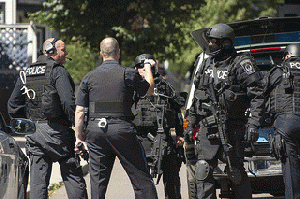"There are always risks in challenging excessive police
power, but the risks of not challenging it are more dangerous, even
fatal."--Hunter S. Thompson, Kingdom of Fear: Loathsome Secrets
of a Star-Crossed Child in the Final Days of the American
Century
No longer is it unusual to hear about incidents in which
police shoot unarmed individuals first and ask questions later.
What is unusual is our lack of outrage, the relative disinterest of
our elected representatives, the media's abysmal failure to ask
questions and demand answers, and our growing acceptance of the
status quo in the United Police States of America--a status quo in
which "we the people" are powerless in the face of the heavy-handed
tactics employed by the government and its armed
agents.
However, as I document in my book
A Government of Wolves: The Emerging American
Police State, it's all part of the larger police state
continuum. Thus, with each tragic shooting that is shrugged off or
covered up, each piece of legislation passed that criminalizes
otherwise legal activities, every surveillance drone that takes to
the skies, every phone call, email or text that is spied on, and
every transaction that is monitored, the government's stranglehold
over our lives grows stronger.
We have been silent about too many things for too long, not
the least of which is the deadly tendency on the part of police to
resort to lethal force. However, as Martin Luther King Jr. reminded
us, "There comes a time when silence is betrayal."
For the sake of 13-year-old Andy Lopez, we can be silent no
more. The Santa Rosa teen was shot dead after two sheriff's
deputies saw him
carrying a toy BB gun in public. Lopez was
about 20 feet away from the deputies, his back turned to them, when
the officers took cover behind their car and ordered him to drop
the "weapon." When Lopez turned around, toy gun in his hand, one of
the officers--a 24-year veteran of the force--shot him
seven times. The time span between the deputies calling in
a suspicious person sighting and shooting Lopez was a mere
ten seconds. The young boy
died at the scene. Clearly, no attempt was
made to use less lethal force.
Rationalizing the shooting incident, Lt. Paul Henry of the
Santa Rosa Police Department explained, "The deputy's mindset was
that he was fearful that he was going to be shot." Yet as
William Norman Grigg, a commentator for
LewRockwell.com, points out, such a "preoccupation with "officer
safety' " leads to unnecessary police shootings. A peace officer is
paid to assume certain risks, including those necessary to
de-escalate a confrontation with someone believed to be a heavily
armed suspect in a residential neighborhood. A "veteran' deputy
with the mindset of a peace officer would have taken more than a
shaved fraction of a split-second to open fire on a small male
individual readily identifiable as a junior high school student,
who was carrying an object that is easily recognizable as a toy--at
least to people who don't see themselves as an army of occupation,
and view the public as an undifferentiated mass of menace."
Unfortunately, this police preoccupation with ensuring their
own safety at all costs--a mindset that many older law enforcement
officials find abhorrent in light of the more selfless code on
which they were trained--is spreading like a plague among the ranks
of police officers across the country, with tragic consequences for
the innocent civilians unlucky enough to be in the wrong place at
the wrong time. Yet the fatality rate of on-duty patrol officers is
reportedly
far lower than many other professions, including
construction, logging, fishing, truck driving, and even trash
collection. In fact, police officers have the same rate of dying on
the job as do taxi drivers.
Nevertheless, according to the Bureau of Justice Statistics,
400 to 500 innocent people
are killed by police officers every year. That
does not include the number of unarmed individuals shot and injured
by police simply because they felt threatened or feared for their
safety. This is the danger of having a standing army (which is what
police forces, increasingly made up of individuals with military
backgrounds and/or training, have evolved into) that has been
trained to view the citizenry as little more than potential
suspects, combatants and insurgents.
Consider what happened in Cleveland, when two police officers
mistook the sounds of a backfiring car for gunfire and immediately
began pursuing the 1979 Chevrolet Malibu and its two occupants, a
woman driver and a man in the passenger seat. Within 20 minutes,
more than 60 police cars, some unmarked, and 115 officers had
joined the pursuit, which ended in a full blown-out firefight in a
middle school parking lot that saw
140 bullets fired in less than 30 seconds.
Once the smoke cleared, it quickly became evident that not only had
the officers been mistakenly firing at each other but the
"suspects"--dead from countless bullet wounds--were unarmed. As
the Plain Dealer reports:
Despite varying levels of experience, all 13 officers
who fired their guns--and many who did not--told investigators they
thought deadly force was needed to stop a violent encounter with
two suspects who they believed were armed. "I've never been more
afraid in my life," said Officer Michael Brelo, who fired 49 shots
that night. "I thought my partner and I were being shot and that we
were going to be killed."
Incredibly, no officers were injured in the shooting. Nor was
any apparent effort made to resolve the situation using less lethal
force. Sixty-three of the officers involved in the fatal shooting
have
since been suspended.
I doubt the police officers involved in this massacre are bad
cops in the sense of being corrupt and on the take, or violent and
abusive, or bloodthirsty and trigger happy. Nor are they any
different from most of the cops who patrol communities large and
small across the country. Just like you and me, these officers have
spouses and children to care for, homes to maintain, bills to pay,
and worries that keep them up at night. Like most of us, they
strive to do their jobs as best as they know how, but that's where
the problem arises, because they have clearly been poorly trained
in how to distinguish what is a real threat. They have also been
indoctrinated into the mindset that they have a right to protect
themselves at all cost and empowered to shoot first and ask
questions later with a veritable arsenal of military artillery,
much of which has been provided by the federal government.
These shootings are occurring with such frequency now that
they are quickly forgotten, lost in the morass of similarly
heartbreaking, tragic incidents. It was barely a month ago, for
example, that police in Washington, DC, shot and killed 34-year-old
Miriam Carey after she collided with a barrier leading to the White
House, then fled when pursued by a phalanx of gun-wielding police
and cop cars. Carey's 1-year-old daughter was in the backseat.
Seventeen gun shots later, Carey was dead and her toddler
motherless. It was what is known as a "bad shoot." As
James Mulvaney, a professor of law and police
science, explains: "A "good shoot' in police lingo is one in which
officers use deadly force to prevent a suspect from inflicting
serious harm. A "bad shoot' is one in which there might have been a
nonlethal alternative."
Even the suggestion that there are nonlethal alternatives is
misleading. Nonlethal weapons such as tasers, stun guns, rubber
pellets and the like, introduced with a government guarantee of
safety for the public and adopted by police departments across the
country purportedly because they would help restrain
violent individuals, have resulted in police using them as
weapons of compliance more often and with less restraint--even
against women and children--and in some instances, even causing
death.
Researchers have discovered that dehumanizing weapons like
guns or tasers, which do not require the aggressor (police) to make
physical contact with his victim, are aggression-eliciting stimuli.
One study found that simply showing an image of a gun to students
caused them to clench their fists faster (a sign of aggressive
effect) when presented with an aversive situation. If a simple
handgun can noticeably increase violent behavior, one can only
imagine what impact the
$500 million dollars' worth of weapons and armored
vehicles (provided by the Pentagon to local police in states
and municipalities across the country) have on already tense and
potentially explosive situations.
So what is the answer?
How should we as a society respond when we hear about the Las
Vegas police officer who shot an unarmed man at a convenience store
whom he "thought" was a homicide suspect, or the Los Angeles cop
who
shot an unarmed man seen leaving a convenience
store where an ATM had been robbed of $40 or the DC cops who
killed a young mother in a hail of gunfire? As
John Grant notes for
Counterpunch:
"The ignominious and unnecessary public killing of Miriam Carey
should be a human marker that triggers our cultural meaning machine
to honestly consider what's wrong with the picture of a howling
pack of cops shooting down a troubled young mother " like a
dog."
The current practice is to let the police deal with it
themselves by suspending the officer involved with administrative
pay, dragging out the investigation until the public forgets about
the incident, and then eventually declaring the shooting incident
justified based on the officer's fear for his safety, and allowing
him to go back to work as usual. Meanwhile, the epidemic of
police violence continues to escalate while
fear of the police increases and the police state, with all its
surveillance gear and military weaponry, expands around us.
If ever there were a time to de-militarize and de-weaponize
local police forces, it's now. The same goes for scaling back on
the mindset adopted by cops that they are the law and should be
revered, feared and obeyed. As for the idea that citizens must be
compliant or risk being treated like lawbreakers, that's nothing
more than authoritarianism with a badge. As Grant
points out: "As the public killing of Miriam
Carey should make clear, a significant part of the problem is cops
and the pack mentality they too often resort to. These men and
women are encouraged to see themselves on "the front line"
protecting us, the people. They are pumped up with post-911 fears
and adrenaline and, when it hits the fan, relentlessly determined
to get their man or woman. A lot of reality can get lost in this
process."
In other words, it's time for a reality check, for both the
police and the citizens of this nation, and a good place to start
is with the words of that gonzo journalist Hunter S. Thompson, who
warned: "Coming of age in a fascist police state will not be a
barrel of fun for anybody, much less for people like me, who are
not inclined to suffer Nazis gladly and feel only contempt for the
cowardly flag-suckers who would gladly give up their outdated
freedom to live for the mess of pottage they have been conned into
believing will be freedom from fear."






